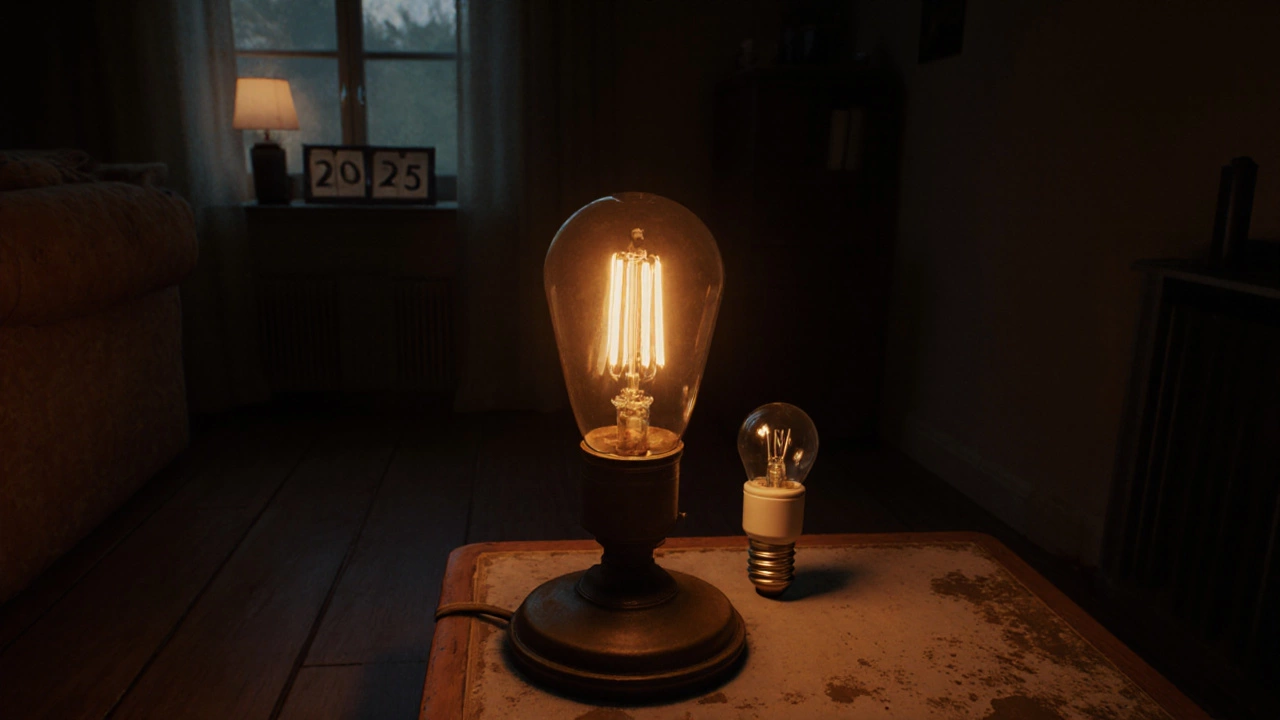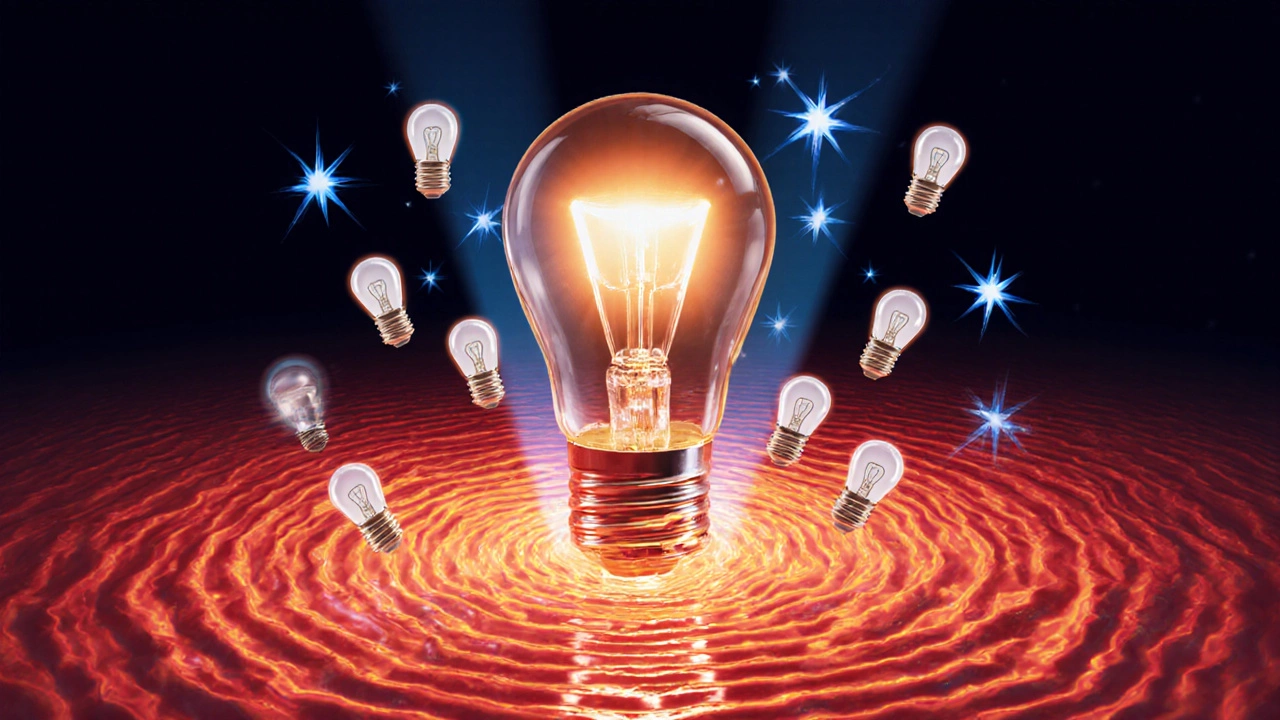
Energy Savings Calculator
See Your Savings
Calculate how much you save by switching from incandescent to LED bulbs. Enter your current usage to see your potential annual savings.
Savings Potential
$0.00
Incandescent Energy
0.00 kWh/year
LED Energy
0.00 kWh/year
If you still have incandescent light bulbs in your home, you’re paying more than you should-every single month. These old-school bulbs turn over 90% of the electricity they use into heat, not light. That’s not a bug. It’s how they’re designed. In a world where LED bulbs use 75% less energy and last 25 times longer, sticking with incandescent lighting is like driving a 1985 hatchback to work while everyone else drives a hybrid.
How incandescent bulbs actually work
Incandescent bulbs produce light by heating a thin tungsten filament until it glows white-hot. This process is called thermal radiation. It’s the same way a stove burner glows red when it’s hot. The problem? Most of the energy goes into making heat, not visible light. Only about 5% of the electricity becomes actual illumination. The rest? Wasted as heat you can feel on your hand if you touch the bulb after it’s been on for a minute.
Compare that to an LED bulb, which uses semiconductors to create light directly. No heating required. No glowing filament. Just electrons moving through a material and releasing photons. That’s why an LED bulb that produces the same amount of light as a 60-watt incandescent only uses 8 to 10 watts. The difference isn’t subtle-it’s dramatic.
Real-world energy waste
Let’s say you have ten 60-watt incandescent bulbs in your home, and you leave them on for five hours a day. That’s 3,000 watt-hours, or 3 kilowatt-hours, every day. Over a year, that’s 1,095 kilowatt-hours. At New Zealand’s average residential electricity rate of about 30 cents per kWh (as of 2025), that’s $328.50 a year just to light your house.
Now swap those same ten bulbs for 8-watt LEDs. Same brightness. Same five hours a day. Now you’re using just 400 watt-hours daily, or 146 kilowatt-hours annually. That’s $43.80. You just saved $284.70 a year. That’s more than enough to cover your monthly internet bill-and you didn’t even have to change your habits.
And that’s just one household. Multiply that across millions of homes still using incandescent bulbs, and you’re talking about gigawatts of wasted energy. In New Zealand, where electricity is mostly renewable, that waste still strains the grid during peak times and increases the need for backup fossil-fuel plants.
Why people still use them
You might wonder: if they’re so inefficient, why do they still exist?
Some people cling to them because they like the warm, yellow glow. Others bought them in bulk during a sale and refuse to toss them. A few think LEDs are too expensive upfront-even though a single LED bulb pays for itself in under six months in energy savings.
There’s also the myth that turning lights on and off shortens LED life. That’s false. LEDs don’t have filaments. They’re not affected by switching. In fact, leaving incandescent bulbs on for hours to avoid "wearing them out" is the exact opposite of what you should do.
And then there’s the emotional attachment. Old bulbs feel familiar. They’ve been in homes for over a century. But familiarity doesn’t make something smart. A horse-drawn carriage feels nostalgic too. That doesn’t mean you should use one to commute.

What’s worse than incandescent?
Is there anything worse? Technically, no. Incandescent bulbs are the least efficient type of lighting ever widely used in homes. But some older technologies come close.
Halogen bulbs are a type of incandescent with a bit more efficiency-maybe 10% to 15% better. But they still waste 85% of their energy as heat. They’re hotter to the touch, a fire risk near curtains or insulation, and often used in recessed lighting where heat buildup is dangerous.
Compact fluorescent lamps (CFLs) were the first real alternative to incandescents. They’re about four times more efficient. But they contain mercury, take seconds to warm up, flicker annoyingly, and degrade faster if switched on and off frequently. They’re better than incandescent, but still far behind LEDs.
So while halogens and CFLs are inefficient too, they’re not the worst. Incandescent is the clear loser.
What you should replace them with
There’s only one sensible replacement: LED lighting. Modern LEDs are bright, instant-on, dimmable, and available in every color temperature-from warm 2700K (like incandescent) to cool 5000K (like daylight). You can even get smart LEDs that change color with your mood or sync with your music.
Look for bulbs with the ENERGY STAR label. They meet strict efficiency and lifespan standards. A good LED will last 15,000 to 25,000 hours. That’s 15 to 25 years if you use it 3 hours a day. Most incandescents last 1,000 hours. You’ll replace one LED bulb in the time you’d replace 15 to 25 incandescents.
And prices? LEDs that cost $15 a decade ago now sell for $2 to $5. Many stores offer discounts when you buy in packs. Some utility companies even give rebates for switching.

What to do with old bulbs
Don’t just throw incandescent bulbs in the trash. They’re not hazardous, but recycling them keeps glass and metal out of landfills. Most hardware stores and recycling centers accept them. If you’re unsure, check with your local council-Auckland Council, for example, has drop-off points at transfer stations.
For CFLs, you must recycle them. Mercury content means they can’t go in regular trash. Many lighting retailers take them back for free.
Why this matters beyond your bill
Switching from incandescent to LED isn’t just about saving money. It’s about reducing your home’s carbon footprint. Every kilowatt-hour you save means less coal, gas, or hydroelectric strain. In New Zealand, where we pride ourselves on clean energy, wasting electricity on outdated tech undermines that identity.
It’s also about comfort. LEDs don’t overheat. They won’t scorch your lampshades. They’re safer around kids and pets. And because they don’t flicker, they’re easier on the eyes-especially at night.
There’s no downside. No trade-off. No compromise. Just better light, lower bills, and a smarter home.
What to do next
Start by replacing the bulbs you use most. Kitchen, living room, hallway-anywhere lights stay on for hours. Then work your way through the house. Don’t feel pressured to do it all at once. Even replacing five bulbs saves you over $100 a year.
If you’re unsure what to buy, look for these specs:
- Wattage equivalent: Match your old bulb (e.g., "60W equivalent")
- Lumens: Aim for 800 lumens for a 60W replacement
- Color temperature: 2700K to 3000K for warm, cozy light
- Dimmable: If your switch is dimmable, get a dimmable LED
- ENERGY STAR: Look for the logo
Within a year, you’ll wonder why you waited so long.
Are incandescent bulbs banned?
They’re not outright banned in New Zealand, but most traditional incandescent bulbs have been phased out of retail sale since 2020 under energy efficiency regulations. You can still find them in old stock or online, but they’re increasingly hard to come by. Retailers are required to stock only efficient alternatives.
Do LEDs really last 25 years?
They can, but it depends on usage. A bulb rated for 25,000 hours will last about 25 years if used 3 hours a day. If you leave it on 12 hours a day, it’ll last around 5 to 6 years. The rating is based on average use, not continuous operation. Still, it’s far longer than any other bulb type.
Why do some LEDs flicker?
Flickering usually comes from cheap drivers or incompatible dimmers. Not all LEDs are made equal. Buy reputable brands (Philips, GE, Cree, or local ones like LEDVANCE) and pair them with dimmers labeled "LED-compatible." Cheap no-name bulbs often cut corners on the internal electronics, leading to flicker or buzzing.
Can I use LEDs in enclosed fixtures?
Yes, but only if the bulb is rated for enclosed fixtures. Heat is the enemy of LEDs. Some are designed with better heat sinks and can handle the trapped heat. Check the packaging-it’ll say "Enclosed Fixture Rated" or "Suitable for Enclosed Fixtures." Don’t assume all LEDs are safe.
Is it worth replacing bulbs one at a time?
Absolutely. Waiting until a bulb burns out means you’re wasting electricity for months or years longer than needed. Replace them as you can afford to. Even replacing one bulb a month will cut your lighting bill by half within a year. You don’t need to do it all at once-just start.




